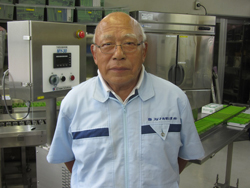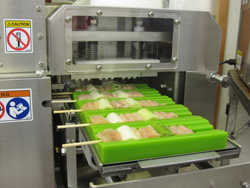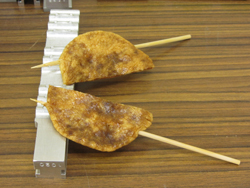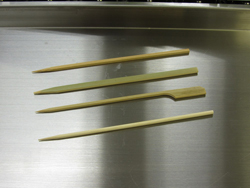Meet Japanese Companies with Quality
Skewering the Competition Kojima Giken Kogyo Ltd.
Website: Kojima Giken Kogyo Ltd.![]()
Category: Japanese Machinery
Grilled meat on a stick
Whether called shish kebab, satay or yakitori, the practice of spearing cut meat and grilling it over an open flame is a part of food cultures around the world. In Japan, yakitori (grilled chicken) is prepared with chunks of different chicken parts speared with bamboo sticks. Although the spearing has traditionally been done by hand, companies are increasingly letting automation handle the task.

Founder and President Minoru Kojima

One type of skewering machine that has prepared five skewers
A new design
Automation is where Kojima Giken Kogyo Ltd. has found its niche, claiming nearly 90% of Japan's market share - a remarkable feat considering that the company was not nearly the first to make such machines when it was founded in 1981. In fact, founder Minoru Kojima says there were already 20 several companies in the field when a popular restaurant asked him to develop a machine. "It's a good thing I didn't know that, or else I probably wouldn't have tried to make one," says Kojima with a chuckle. Ignorance of the market proved an asset; instead of copying competitors, Kojima used his engineering background to create a new design, going to the customer's shop and studying just how cooks prepared yakitori.
Competitors couldn't take the heat
Kojima found out later, of course, about the other manufacturers, but he learned that their products had left something lacking, the passion and spirits towards manufacturing. Word of mouth quickly spread about his machines and orders increased. Competitors eventually fell by the wayside, which Kojima attributes to the fact that they "lacked the heart to really make the machines. They just wanted to sell a product and weren't really concerned with the needs of customers".
Simple, smooth operation
Kojima's machine has a simplicity that belies the amount of thinking and research required for its development. Operators first arrange the materials to be skewered on a special mold, which is then either placed alongside other molds on a tray and inserted into the machine, or brought to the main mechanism by a conveyor. A metal stabilizer presses down on the mold's ingredients while a wood skewer is pushed through the mold lengthwise. Kojima's equipment can skewer quickly and reliably for ingredients as thin as 3 mm- nearly the thickness of the skewer itself.

Rice cracker skewers
Try before you buy
Others tried to copy his original design, but rather than fight an expensive legal battle over patents, Kojima says he opted to develop superior technology to better accommodate his customers. Moreover, Kojima is unperturbed about rivals, saying, "It's good to have competitors because it allows us to be compared." He relates how customers considering other manufacturers are often won over after trying out the product at Kojima Giken's assembly site in Kanagawa Prefecture.

Kojima Giken sells skewers as well.
The world takes notice
In addition to growing interest in Asian countries such as Korea, China and Indonesia, demand is also expanding in Europe, such as in Sweden, where grilling seafood on a stick is popular. Regardless of how customers use the machines, Kojima Giken has their needs in mind - they've even got the bamboo skewers covered as well.
Website: Kojima Giken Kogyo Ltd.![]()



